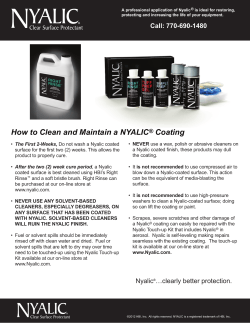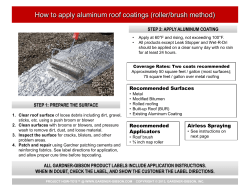
Understanding How to Extend Tool Life with Coatings: An Overview
Understanding How to Extend Tool Life with Coatings: An Overview 2013 PMPA National Technical Conference April 15, 2013 - Columbus, Ohio Columbus- April, 2013 • Process Technology- Manufacturers and Techniques – CVD – PVD – CVD Diamond • • • • Coating Selection by Application Critical Factors Relating to Performance Designing a Coated Tool On the Horizon Columbus- April, 2013 CVD vs: PVD Technologies Inserts, Dies and Punches. Heat treating Req’d post coating on Tool Steels Shaft tools, Inserts molds- Tool Steel and carbide. Moderate Temp Columbus- April, 2013 Application CVD HT – CVD MT – CVD MO – CVD PA – CVD LP – CVD PVD Methods Evaporation Sputtering EB-PVD Arc ABS Thermionic IBAD MW – CVD LAPVD UBM HiPIMS HIS HIP Transport space Source Substrate CVD Process PVD Process Columbus- April, 2013 PVD Equipment Manufacturers Balzers Platit Sulzer Metaplas PVT Nachi CemeCon Columbus- April, 2013 Lafer Evolution of Coating Materials FUTURA TOP FUTURA Nano SUPERNITRIDE Alcrona G6 HPN 1 2012 2000 TiN 2005 2001 2003 2008 HARDLUBE 70 1980 60 Commercial PVD Films for Cutting Tools 50 1999 New TINALOX TiCN 40 30 20 1985 10 TiAlN 0 1980 1999 Fire X X.TREME 1988 2010 TiB2 BALINIT® C FUTURA 1988 1996 Columbus- April, 2013 1998 1997 1996 1995 1993 TINALOX-TiAlN Source: Balzers/CemeCon/Sulzer/Ionbond/P CVD Diamond 6-8µ • graphite • carbide green compact • ceramic green compact Co-concentration 6%* CVD Diamond 8-10µ Nano Crystalline Co-concentration 12%* CVD Diamond 12µ • fiber glass reinforced plastics • carbon fiber reinforced plastics Co-concentration 12%* • composite- and sandwich-materials such as Al-Ti- or Ti-CFK composite materials etc. • AlSi- and TiAl-Alloys • MMC-materials • mineral filled plastics etc. CVD Diamond Multilayer Co-concentration 12%* Columbus- April, 2013 * Crystalline Multilayer Cutting Tool Coating Production Dedicated production processes to meet the different geometries, surface conditions, and application of the tools. Cutting Inserts Round Tools Hobs Diamond Coated Tools Product and Application specific production plans Columbus- April, 2013 Machining Properties of Various Steels Matched to Coating Chemistry AlTiN TiAlSiN MOLD STEELS 600 550 TiAlCrN 500 450 AlCrN HARDENED ALLOY STEELS 400 Increased coating heat resistance 56 54 51 47 TiAlN Ni-based SUPERALLOYS 350 HRc 35 TITANIUM ALLOYS 300 250 GREY CAST IRONS 200 STAINLESS STEELS DUCTILE IRONS 150 100 50 LOW CARBON STEELS Short chips 0 0 23 ALLOY STEELS 10 Long chips 20 Elongation, % Columbus- April, 2013 30 40 Coating Selection Based on Cutting Conditions Coating Property Coating Thermal Stability Cutting Condition HighHot AlTiAlSiN HighHot Dry HardBrittle AlTiN Cutting Method High Speed – Small Chips AlTiCrN & AlCrN TiAlN TiCN Wet LowCool TiN Columbus- April, 2013 High Feed – Large Chips Tough Goal: Match the Coating to the Tool Design and Application Product Performance determines Productivity Substrate Adapted the coating to the optimum configuration Columbus- April, 2013 Geometry Coating History of the Coating Industry One Fits All TiN 1980’s List of Coatings TiN TiCN CrN TiAlN AlTiN Al2O3 … Design Dedicated Coatings 1990’s Columbus- April, 2013 Today Design of Optimized Coatings Coating = cleaning + pre-treatment + coating material + coating thickness + tolerance Design a coating in four steps: 1. Definition of the objective 2. Definition of coating specification 3. Production of test tools, evaluation and, if necessary, optimization 4. Final specification Columbus- April, 2013 Modifying the edge preparation & surface quality to match the application and cutting conditions is a standard process for some manufacturers Slide provided Courtesy of Tool Alliance Columbus- April, 2013 • Definition of Objective – Material to be machined • Properties, Chemistry, etc – Cutting Conditions • Wet or Dry • Speeds and feeds req’d. – Tool Geometry Required • Type, cutting edge condition, material, etc. – Likely Failure Mechanism • Notching, Micro Cracks, Adhesive transfer of work piece, abrasion, etc. – Finish required • Definition of Coating Spec. – Select a coating chemistry compatible with the work piece – Dry or high speed requires a thermally stable coating. (ie: AlTiN either Hard or Tough) – Insert, Round Tool, sharp edge for finish, Carbide, HHS , etc. – Empirical process from experience. This factor combined with edge preparations will determine coating thickness required. Columbus- April, 2013 Example Cutting of Non Ferrous Alloys- Aluminum, Copper, Titanium • When machining alloys of Al, Cu or Ti there are many similarities. – Finish is Critical – Minimum Lubrication is preferred – Highest metal removal is desirable – Sharp Cutting edges are required. – Effective chip ejection is req’d. – Failure mechanism for soft alloys is usually adhesive transfer. BUE – Failure for Ti Alloys is abrasive wear. • Coating Specification- High cutting speeds in these materials will generate more heat, accelerating either adhesive transfer or abrasive wear. From history we know 3µ coatings will dull the cutting edge. The preferred choice has been uncoated carbide tooling. Titanium Di-Boride coatings have two critical properties, anti wetting and high hardness to address failure mechanisms. AlTiCrN is encouraging for Ti Alloys. – Pretreat the tool for best surface finish – Apply the coating at 1.5-2µ – Post treat the tool for best coated finish Columbus- April, 2013 On the Horizon • The coating industry currently is focused on three key developments: – Improve Adhesion – Improve Structure – Reduce Stress New Coating Interface Scratch Test New 130N • Productivity improves if we can make the coating stick better. Old 70-90N Columbus- April, 2013 On the Horizon- Adhesion Industry Focus Modern Technology HPPMS - High Pulsed Power Magnetron Sputtering 1000 900 power / kW 800 700 600 500 400 300 200 100 0 0 5 10 15 20 25 30 35 Columbus- April, 2013 time / ms 40 45 50 conventional coating s = -4 GPa s = -1 GPa Shear force s = -2 GPa Adhesion <Shear force Adhesion > Shear force 3 µm 12 µm 6 µm Coating Thickness [µm] Columbus- April, 2013 residual stress Conclusions Questions that are always asked!! • Is one PVD coating technique or coating better than others? – No! The key is in the consistent application of the process monitoring thickness, adhesion, structure and finish. • Is there a difference between coated tools received from the toolmaker and coating applied in the aftermarket? – There can be. Most OEM’s are designing tools with geometry and edge prep to optimize coating integration. Most C/S companies select a generic process to apply to many different tool types. Columbus- April, 2013 Conclusions • It is unlikely that there will be any significant advances in coating chemistry in the near future. • It is equally unlikely that a magic coating will be introduced for all applications. • Tool manufacturers are developing application specific product lines optimizing the choice of coating to the application and the tool geometry. • The development of new coating process technology like HPPMS and improved etching will be slowly integrated over the next years by all PVD equipment designers. • Improving adhesion of the PVD coating offers the best bang as it relates to productivity improvement. • Virtually all current coating designs will benefit from this type of development. Columbus- April, 2013 What’s the End User’s Role? • • The end user has the most significant information that can help the tool maker and coating supplier (sometimes one in the same), to improve the performance and productivity of a machining operation. Determining the Failure Mode. The US distribution method for cutting tools can place as many as four levels between the end user and the designer. As you go forward the role for the end users with the highest return is to provide your observations when a tool or coating fails. This can be a critical step in adapting a coating or tool to optimize a machining operation. Columbus- April, 2013 Thank You For a virtual tour of a PVD coating facility use the search words “coating center” at www.youtube.com Columbus- April, 2013
© Copyright 2025





















